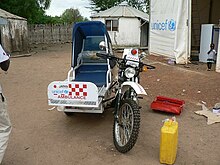Motorcycle ambulance: Difference between revisions
| Line 26: | Line 26: | ||
==Manufacturers== |
==Manufacturers== |
||
A number of manufacturers worldwide continued to produce sidecar for many popular motorcycles and scooters |
A number of manufacturers worldwide continued to produce [[sidecar]]s for many popular motorcycles and scooters. |
||
Active '''motorcycle ambulance''' manufactures are listed here: |
Active '''motorcycle ambulance''' manufactures are listed here: |
||
The Ranger Production Company |
The Ranger Production Company |
||
Revision as of 16:01, 31 October 2009

Motorcycle ambulances are a type of emergency vehicle able to respond to a medical emergency much faster than a car or van in heavy traffic. A motorcycle ambulance may be equipped with a trailer or sidecar for transporting patients.
Worldwide Motorcycle Ambulances
Japan
Some Japanese fire departments use off-road motorcycles as emergency vehicles. They are useful for negotiating the small streets and heavy traffic in some areas. They would likely work in teams of two or three motorcycles. One of the motorcycles carries a first aid kit and a trained first responder. The other motorcycles carry fire fighting and rescue equipment.
Malawi and Sudan

They have been used in remote rural areas in Malawi and Sudan as a means to improve access to health care facilities for women in labor or needing prenatal care. Lightweight off-road motorcycles, equipped with a sidecar holding a stretcher for the patient, have been found to be an efficient supplement, but not replacement for, 4-wheel drive SUV ambulances. Purchase prices and operating costs have been found to be a fraction of a four wheeled vehicle, and the sidecar rigs have been found to be less likely to be misused by diverting them for non-healthcare purposes. The lighter sidecar rigs are better able to cope with poor roads and areas that become impassible to heavier cars and trucks during the rainy season. Disadvantages include the reluctance of drivers to travel at night in some cases, and the inability to carry more than one patient at a time.[1][2]
Here is the conclusion from the report
Motorcycle ambulances for referral of obstetric emergencies in rural Malawi: Do they reduce delay and what do they cost?[3] Motorcycle ambulances reduce the delay in referring women with obstetric complications from remote rural health centers to the district hospital, particularly under circumstances where health centers have no access to other transport or means of communication to call for an ambulance. They are also a relatively cheap and effective option for referral of patients in developing countries, particularly in rural areas with little or no public transport. Nineteen motorcycle ambulances can be bought for the price of one Toyota Land Cruiser car ambulance. Operating costs compare in a similar way. Motorcycle ambulances also potentially help reduce costs for women and their families to access EmOC, although this was not the subject of this study.
United Kingdom
Motorbikes are used as Rapid Response Vehicles for the medical services in the United Kingdom.
Also See
Manufacturers
A number of manufacturers worldwide continued to produce sidecars for many popular motorcycles and scooters.
Active motorcycle ambulance manufactures are listed here:
The Ranger Production Company
References
- ^ IRIN (1 April 2009), SUDAN: Biking for safer childbirth; A motorbike ambulance is test driven in South Sudan at the launch of a pilot project aimed to cut maternal mortality, Integrated Regional Information Networks (UN Office for the Coordination of Humanitarian Affairs)
- ^ Kelly, Liz; Ford (13 May 2009), "Could motorbikes cut deaths in childbirth in Africa?", The Guardian
- ^ Dzimadzi, Chris; Lungu, Kingsley; Ratsma, Esther Y. (2008), "Motorcycle ambulances for referral of obstetric emergencies in rural Malawi: Do they reduce delay and what do they cost?" (Adobe PDF), International Journal of Gynecology & Obstetrics, 102 (2), International Federation of Gynecology and Obstetrics: 191–197, doi:10.1016
{{citation}}:|first1=missing|last1=(help);|first5=missing|last5=(help); Check|doi=value (help); Missing pipe in:|first1=(help); Missing pipe in:|first5=(help)CS1 maint: numeric names: authors list (link)
